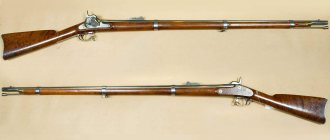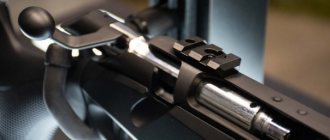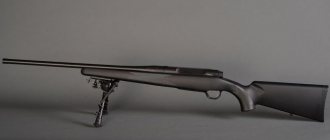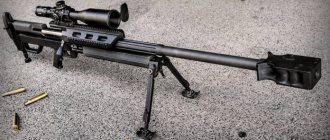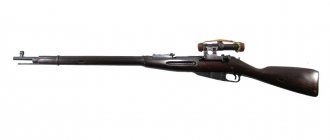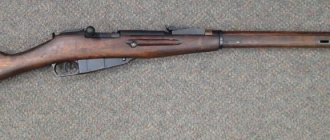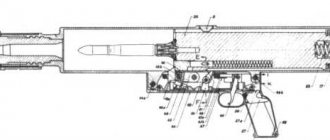12.03.2021
For many years, carbines have remained a popular weapon for hunting and defense. They are taken for fishing in hot summers and in winter frosts. With a carbine they catch small game, and without fear they lie in wait for a large animal or a dangerous predator. Forest thickets, open desert, mountainous terrain - the carbine will cope with tasks in any conditions.
Definition
A carbine is a lightweight rifled gun, or rifle with a shortened barrel. There are also smooth-bore models on sale, but there are much fewer of them.
The word “Karab” came to us from Arab countries, translated it means “weapon”; later the Turks called the shooters “karabuli”, and the French used the concept “carabineer” for this.
The first carbine was invented in 1498 in France by gunsmith Gaspard Zollner. Over 5 centuries, the carbine has traveled a long historical path, taking part in hundreds of wars and thousands of battles.
Now the carbine is a reliable and popular weapon for hunting and self-defense. The reduced weight and shortened barrel do not interfere with the hunter during long walks on foot, maintaining all the combat characteristics of a classic rifled weapon for hunting.
There is no clear answer to the question: which carbine is better. Therefore, every hunter chooses a weapon according to the characteristics known to him. Let's discuss in detail the choice of a hunting rifle, its capabilities and basic parameters.
How the carabiner works
Before choosing a carbine, study the reloading methods and operating principles of the designs.
Bolt action carbine
Bolt-action weapons were shown to the general public and used in combat as early as 1841. Simple design and high reliability allow carbines to remain a popular model of hunting weapons.
The longitudinal bolt mechanism opens and locks the muzzle channel by moving the bolt along the axis of the barrel. This movement is direct and progressive, with a return to the starting position.
The shutter movement performs two functions at once. This includes feeding the cartridge into the chamber, and then removing the spent cartridge case. To engage the bolt with the barrel, a rotating mechanism, skew or engagement by a combat cylinder is provided.
Advantages of a longitudinally sliding shutter design:
- Carbines can withstand high pressure of powder gases when fired, which makes it possible to use cartridges with high lethal force in hunting to kill large animals.
- Quick extraction of spent cartridges.
- High shooting accuracy.
- Reliability and longevity.
The disadvantages are:
- Slow rate of fire during series of shots, since the carbine has to be reloaded manually after each shot.
- The shooter's movements when reloading lead to the fact that the sight is lost and he has to look for the hunting object again.
- It is more suitable for experienced shooters, since after the first ineffective shot the game may become frightened and move out of sight. Owners of bolt action rifles have no room for error.
Semi-automatic self-loading weapon
These are carbines that are reloaded automatically, without additional actions on the part of the hunter. Typically, the carbine design is equipped with a magazine with a capacity of up to 10 rounds. The owner of such a weapon can fire in series at a fast pace, which increases the efficiency of shooting, and therefore the productivity of hunting.
Return of the bolt and extraction of the spent cartridge case occurs automatically under the influence of powder gases. In the next stroke, with the participation of a spring mechanism, the bolt places the cartridge into the chamber with a return movement. The cartridge is fed by the spring block in the magazine.
Pros of semi-automatic self-loading carbines:
- The high rate of fire is effective when driving game.
- The absence of additional actions on the part of the hunter to load the carbine allows him not to lose sight after a shot, which also increases the speed of subsequent shots.
- Self-loading weapons demonstrate advantages for winter hunting. Since the shooter does not need to take off his gloves to reload, this means better heat retention.
The disadvantages were:
- Reduced accuracy and accuracy of shots compared to the previous design.
- Self-loading semi-automatic carbines are more demanding to maintain, and if not regularly maintained, they may malfunction in this regard.
A fitting or carbine with a breaking barrel
The fitting is a carbine with a movable shaft and a fixed bolt. This design is also called a swing barrel. To reload, the barrel is tilted or refracted, deviating downward from the longitudinal axis of the weapon. This happens due to the presence of a special hinge in the design. The cartridges are placed into the chamber manually, and the cartridge case can be removed spontaneously when the barrel is refracted. Although in some versions of carbines, spent cartridges have to be removed manually.
Pros:
- Compact and highly reliable swing barrel design.
- High killing power, allowing you to hunt large prey from close distances.
- The rifles are superbly balanced and have good grip, making them a favorite weapon for many hunters.
Let's name the disadvantages:
- Short firing range - the distance to the game should be no more than 200 meters.
- The high cost of such models compared to bolt-action rifles.
Thus, when choosing a carbine based on its operating principle, the following recommendations can be made:
For beginners, carbines with a bolt-action trigger mechanism are suitable, as they are the most reliable designs with high efficiency of firing single shots followed by manual reloading.
Experienced hunters and people who make money from this craft should pay attention to high-speed, self-loading semi-automatic options.
Connoisseurs of quality and comfort prefer swinging barrel modifications. These are retrogrades who respect traditions and comfort.
Bolt-action rifles: by country and continent (part 3)
“...seeing they do not see, and hearing they do not hear, and they do not understand” (Gospel of Matthew 13:13)
In the two previous materials, we examined the genesis of the sliding shutter and saw that its development followed two paths almost simultaneously. In the first case, a sliding bolt in the form of a piston was used in rifles chambered for the most common paper cartridges for capsule guns at that time. In the second, they were used in rifles that fired metal cartridges with ring and primer ignition. Intermediate type - paper cartridges for Dreyze, Chassepot and Carcano needle rifles. However, such cartridges were soon completely replaced by cartridges with metal sleeves. The latter, also at the beginning, like, for example, the American Barnside cartridge, although they had a sleeve, did not have a primer. However, they did not last long, since cartridges with center firing primers were definitely more advanced than them. However, the sliding shutter at the turn of the 60-70s. XIX century has also established itself as the most rational and technically advanced bolt for a mass-produced army rifle!
Lorenz Dorn fitting of the 1854 model, produced in Austria-Hungary to arm its army.
Well, now, as promised, we will go on a journey through countries and continents and see what rifles with what sliding bolts their armies were armed with in the last quarter of the 19th and early 20th centuries. The very first country on our way will be Austria, which was called Austria-Hungary at that time and had a very funny national flag with two coats of arms and three horizontal stripes: the top red, the middle white, and the bottom double, first red (Austria), behind then green (Hungary).
Let's start with the fact that the industrial base for the production of small arms in Austria-Hungary was created by Leopold Werdl. Already at the end of 1840, his enterprise employed more than 500 workers. He traveled to the USA, visited the factories of Colt, Remington and Pratt and Whitley and organized a business based on their model. After Leopold's death in 1855, his business was inherited by his two sons, one of whom, Joseph, again went to America in 1863 to work at the Colt and Remington factories. Returning to his hometown of Steyr, he reorganized production and eventually created a first-class armory (OEWG) in Vienna in 1869.
He was also involved in design activities. The single-shot carbine with a tap action designed by him was adopted by the Austrian-Hungarian army. Following this, a successful project was the work of the Viennese gunsmith Ferdinand Fruhwirth, who created an 11-mm carbine with an under-barrel magazine and a sliding bolt with locking by turning. In total, it held 8 cartridges, which, if desired, could be shot in 16 seconds, and loaded with six cartridges in 12. This was the first repeating carbine chambered for centerfire cartridges. Testing continued from 1869 to 1872, when it was officially adopted by border guards and gendarmes. But for the army it turned out to be too fragile, so its production was discontinued in 1875.
Ferdinand Fruhwirth's carbine design.
At first glance, there was nothing special about Fruhwirth's design. Similar rifles were offered by many designers and companies. However, despite the fact that the carbine was criticized for the too weak Root cartridge from Hungary, it should be emphasized that it embodied many original solutions that could subsequently be used in other, later designs, but... no, it was truly said: “They have eyes and do not see!”
Fravirt carbine. Note the very long length of the bolt handle.
For example, the Fruwirth sliding bolt had a very long handle in the shape of the letter “L”, rotated 180 degrees, which was attached to the side of the bolt on the right at a right angle. That is, it was enough to turn it to a horizontal position to disengage the bolt from the receiver. In addition, a large length means a large lever, so working with such a handle was very convenient. And what’s interesting is that only many years later they began to use exactly the same long bolt handles, but what prevented them from doing this from the very beginning, as soon as it first appeared on Fruvirt’s carbine? Patent rights? But they could be obtained on the method of attaching it to the bolt, but not on the length!
The design of a Mannlicher rifle with an under-barrel magazine, 1882.
Be that as it may, in 1880 Austria-Hungary began to look for such a model of rifle so that it could serve for many years. And then Ferdinand Mannlicher appeared on the stage. He was a railway engineer by training. Weapons were his hobby - that’s how it is, but a hobby of such a level that in 1876 he specially went to the World Exhibition in Philadelphia to get acquainted with the latest models of small arms. In 1880, he designed his first rifle with a tubular magazine in the stock, then in 1881, a rifle with a central magazine and a pusher based on a coil spring, and then in 1885, his first rifle with a central magazine and a direct action bolt, adopted for service. next year. The cartridge for it was initially adopted in caliber 11.15x58R, but then replaced by 8x50R on the M1886/90 conversion model.
It should be noted that Ferdinand Mannlicher was a very creative person and offered new rifles literally one after another. I didn’t like a rifle with an under-barrel magazine - here’s one with a middle one, but located on top (M1882) - fig. up. Seven cartridges, you can fill them loosely, and no springs or magazines. Convenient, isn't it? Too many bullets? Here is the 1884 model - fig. at the bottom. That is, everything that was popular at least for a short time - such as Fosbury and Lindner magazines, he immediately installed on his rifles and tested them, trying to find the best option.
The device of the Mannlicher M1886 rifle.
M1886 rifle. (Army Museum, Stockholm)
And this is what the 11.15x58R cartridges and clip for this rifle looked like. The corrugation at the top made it easier to remove from the magazine.
Improving this model, Ferdinand Mannlicher designed the M1888 rifle, planning it for the new 8x50R cartridge with smokeless powder from the very beginning.
The design of the Mannlicher M1888 rifle.
M1888 rifle. (Army Museum, Stockholm)
Carbine devices 1890
Cavalry carbine 1890 (Army Museum, Stockholm)
Consistently improving his rifle, Mannlicher developed the 1895 model, which was also adopted for service. Austria-Hungary participated in World War I with this rifle and produced it until 1916, when it was replaced in production by the more technologically advanced Mauser rifle. A characteristic feature of all Mannlicher rifles was a direct action bolt with a handle at the level of the trigger and a pack falling out through a hole in the magazine. An unspent cartridge pack could be removed through the open bolt after pressing the latch located in the rear of the magazine, combined with the trigger guard. It was the lightest and one of the fastest-firing rifles of the First World War.
Bolt for the Mannlicher rifle 1895
As can be clearly seen in the graphic diagrams presented here, the bolt of the Mannlicher rifle consisted of two parts: internal and external. The outer one had a handle and, when moving “back and forth,” turned the inner one due to the presence of corresponding grooves and protrusions on them. In this case, the firing pin was cocked and the cartridge was locked in the chamber due to two lugs located in the front part of the rotating part of the bolt. This design certainly increased both the rate of fire and the ease of working with the rifle, although it was quite sensitive to contamination. However, the Austrians themselves did not complain about this, as well as about the allegedly possible contamination of the magazine through the holes for the clips to fall out. Russian officers criticized this hole a lot, but in real life it turned out that just as the dirt gets there, it is removed through it. Whereas in stores where there was no such hole, without proper care it accumulated in unacceptable quantities. Thanks to the use of a pack, the rifle did not require any “cut-off reflectors” that complicated the design, although the volume of metal lost on each pack was slightly greater than on the clip. In 1930, it was converted to use 8x56R cartridges and received the designation M1895/30.
The design of a rifle made in 1895.
M1895 rifle. (Army Museum, Stockholm)
Austro-Hungarian mountain rifle soldier with a carbine (the Austrians themselves called this model a short rifle) of the 1895 model.
It is interesting that Werndl himself, while engaged in the mass production of modern weapons, continued to engage in design work, and even came up with a rifle with a double-row under-barrel magazine. However, she was not successful.
Werndl rifle with a double-row under-barrel magazine.
To be continued…
Calibers of hunting rifles
Caliber is probably the main characteristic of any type of weapon, be it a hunting rifle or an army pistol. Caliber is the inner diameter of the rifle's barrel.
In past centuries, rifle calibers were measured in lines. Now the recognized quantities are centimeters or inches. The metric system for designating calibers is adopted in Europe and Asia. Inches indicate the caliber of rifles manufactured in the USA. 1 inch is 25.4 mm or 10 lines.
Moreover, each rifled barrel has two channel sizes: along the rifling and along the fields. The groove diameter is smaller because it does not take into account the depth of the grooves. Therefore, its value is considered the true caliber. Ammunition is purchased exactly according to the caliber of the carbine barrel.
The obvious conclusion from the above is that the caliber of purchased cartridges fully corresponds to the caliber of the rifle barrel for safe shooting.
Modern hunting rifles, according to calibers, are divided into groups, which we will dwell on in more detail.
- Large-caliber. Large-caliber carbines include models with a caliber of 9 mm and above. Such weapons are used for hunting particularly large animals: deer, bear, elk, wild boar.
- Small caliber. This is the largest group, which contains carbines with a caliber of 5.6 mm. Such carbines are used in hunting small game, birds, and fur-bearing animals.
Caliber
When choosing a caliber, you need to focus primarily on the size of the intended trophies. For rifled weapons, this characteristic is much more important than for smooth-bore weapons. The energy of the bullet when it hits the animal and its stopping power must be sufficient, then the number of wounded animals can be minimized. These important indicators increase with increasing mass and radius of the ammunition.
Small Game Hunting
Small game means large birds - black grouse, wood grouse, geese - or small animals like foxes. For hunting them with rifled weapons, the 5.6 caliber is well suited.
Calibers for an animal weighing 60-90 kilograms
When it comes to hunting animals up to 90 kilograms - wolf, roe deer, saiga and the like - the best choice would be:
- 5.6 mm;
- 6.5 mm;
- 7 mm;
- 7.62 mm.
An animal weighing 90-150 kilograms
These can be small and medium-sized wild boars, mountain sheep, reindeer or sika deer, small moose and similar animals. For such hunting you can use the following calibers:
- 6.5 mm;
- 7 mm;
- 8 mm.
Hunting for animals weighing 150 kilograms or more
Big game includes large deer such as red deer and wapiti, as well as moose, bear and wild boar. For such hunting you can use the following calibers:
- 7.62 mm;
- 8 mm;
- 9.3 mm.
There is no need to go small with the caliber: let the bullets be superior in energy and stopping power to the ideal ammunition for your conditions. If you make a mistake with the caliber on the smaller side, hunting can turn into complete torture.
There is also no need to chase cheapness when choosing a rifle . This is especially true for carabiners, which have a rather complex design - inexpensive models can be very unreliable. Do not forget that the choice of a hunting weapon is a purely individual matter; try to find a model that you like, and not someone you know, and that is best suited for your hunting conditions. A high-quality carabiner or fitting will serve you faithfully for many years and will bring only positive emotions.
Top 5 domestic carbines
In addition to the technical characteristics given, carbines are selected based on design and cost. And domestic modifications have an advantage in this regard.
Boar
A leader in the segment and a very popular model not only in Russia. This is a carbine with a semi-automatic reloading system. Both rifled and smooth-bore carbines are available for sale. It is used not only for hunting game, but also as a weapon for security and self-defense.
Vepris are distinguished by their reliability and reliability. Which is not surprising, since the prototype of the carbine was the legendary Kalashnikov assault rifle. Thanks to its proven design, the Vepr will not misfire even in the most difficult conditions.
The Boar's caliber is 7.62 mm, which corresponds to standard military ammunition and is therefore widely available in gun stores. At the same time, the carbine is unpretentious and you can use homemade cartridges for hunting.
The weight of the carbine is about 4 kg, so it is suitable for hunters of any configuration and build.
Saiga
The best carbine, appreciated by commercial hunters. Like the Vepr, the Saiga is designed on the basis of the Kalashnikov assault rifle, and has adopted high performance properties and reliability from the prototype.
Hunters love Saiga for its simplicity, reliability and high variability of modifications. But the recoil of the carbine is quite strong, so an untrained shooter will have to get used to it at first. And the weight of the Saiga exceeds the weight of the Boar, so lovers of walking hunting should take this into account in advance.
Sable
A light and thin model weighing only 3 kg, with a caliber of 5.6 mm, popular among hunters of small and medium-sized animals. However, it differs from previous carbines in its reduced operating temperature range - from -30 to +50 degrees Celsius. However, for the central zone of the Russian Federation such limits do not matter. It will fail only when hunting in the far north.
The main advantage of the Sobol is the presence of two magazines in the kit, which gives reason not to worry about a shortage of cartridges.
Tiger
The tiger is the main competitor of the Boar. Since it is also designed for 7.62 caliber and weighs 3.9 kilograms. The tiger was created based on the drawings of the Dragunov sniper rifle. At the same time, the shortcomings of the SVD were eliminated as far as possible by the new engineers.
The carbine is suitable for shooting large prey, including elk and seasoned wild boars. One of the advantages is the good optical sight included in the kit, the magnification of which is enough for hunting in any conditions.
TOZ-78
A popular model thanks to several modifications. This carbine is often purchased as a gift, since some collector's versions are presented with carvings on the muzzle and inlaid with semi-precious stones on the butt.
A small-caliber carbine allows for effective shooting of fur-bearing animals and small game on a commercial scale. This is facilitated by high strength, reliability and accuracy of shots.
The scope of delivery includes an optical sight with 4x zoom.
Top 5 imported carbines
Many experienced hunters prefer to choose foreign-made hunting rifles, explaining this by excellent shooting performance and high build quality.
CZ-550
The Czech hunting carbine, known under the nickname “Chezet”, is a luxury-class modification created on the basis of the Mauser-98 rifle. It is suitable for hunting medium and large animals. Valued by hunters for its high shooting accuracy. The carbine is equipped with a magazine for 4 rounds and a native optical sight with high magnification.
Many hunters are stopped by the rather large weight - about 4.3 kg when unloaded. But for hunting from a manhole, this is the best option.
Remington 700
A world-famous carbine for hunting and self-defense produced by a famous American company. Premium build quality and high shooting accuracy make it an ideal modification for hunting the largest game. In this case, the firing distance ranges from 50 to 300 meters. The carbine is loaded with 223Rem caliber cartridges.
The carbine has several modifications, and the purchase package can also be selected individually.
Winchester Model 70
An American model from 1936, which remains popular today among hunters all over the world.
A carbine with excellent balance, which allows hunters of any configuration and athletic training to use this model. At the same time, the Winchester has quite an impressive weight, but thanks to its balanced design it is not felt.
There are many modifications and configurations of the Winchester, but hunters prefer the classic version with a wooden stock.
Browning M1918
This carbine is based on the rifle of the same name and has been produced since 1967. This is a sought-after hunting rifle not only at home, but throughout the world.
The length of the barrel of various modifications is 510 – 600 mm. The weight of the rifle without body kit is 3.58 kg, which makes it an excellent choice for walking hunting. The carbine is equipped with one of two magazine designs - 4 or 10 rounds.
Shooters praise the model for its light and smooth trigger mechanism, high accuracy and shooting accuracy.
Ruger Mini-14
The German carbine was created under the company's motto: safety, accuracy, convenience. It was developed in 1993 and differs from its competitors in the ability to quickly change the barrel, which allows this weapon to be used for ammunition of various calibers. And, therefore, the area of application of this carbine is extensive - from game birds to large species of animals.
The modification is incredibly popular among hunters and is exported by the manufacturer to 50 countries.
Our rating is not a final verdict. After all, paraphrasing the well-known proverb, we can say with confidence: as many hunters as there are, so many opinions. Therefore, when choosing a carbine, be sure to focus on personal feelings and comfort, and not on the rating or cost of the model.
Advantages and disadvantages
To summarize, let's name the advantages and disadvantages of the carbine.
The advantages of the carbine are:
- Reduced weight compared to a classic long rifle. Even taking into account the slight difference, every 100 grams is important for a hunter. After all, complete hunting equipment has a significant weight. At the same time, a hunter often has to travel many kilometers on foot in search of game.
- The shortened barrel does not interfere with the choice of any position for an ambush. Branches, tall grass and brush will not get in the way as much as if the hunter were holding a full-size rifle. And the shortened version is easier to transport.
- With all the restrictions on weight and size, the stripped-down version is not much inferior to rifles in terms of shooting quality and accuracy.
- A separate plus is the function of continuous shooting without reloading after each shot in semi-automatic models.
- Many carbines have additional functions and tools in their design, for example, the same bayonet-knife, which will help out in a close encounter with a dangerous predator or a wounded animal.
- Price issue. In one category, in terms of quality and manufacturer, carbines will be cheaper than long-barreled weapon configurations.
It would be unfair to overlook the shortcomings:
- The carbine is definitely inferior to the rifle in firing range. If factory production models of rifled guns are capable of hitting a target at a distance of up to 1.5 km, then for a carbine the maximum is only 800 m. Although this distance is sufficient for hunting small and medium game.
- The carbine also loses in destructive power. Still, for hunting large animals and especially predators, it’s worth looking at more productive weapon modifications.
Fittings
Initially, rifled guns loaded through muzzles, which were used from the 16th to the 19th centuries, were called fittings. They were two to three times superior to smooth-bore weapons, and were also distinguished by good shooting accuracy, so they were widely used among the troops. In the middle of the 19th century, up to a third of the soldiers of the advanced armies fought with fittings. However, the low rate of fire and high cost limited the use of such rifles.
In the modern understanding, fittings are a special type of hunting weapon, a rifle with breaking barrels. Such guns are rarely chosen as the first rifled weapon; they are usually purchased after gaining experience in using a carbine. Many experienced hunters prefer them .
The main advantages of fittings:
- the second shot can be fired almost instantly, since all you need to do is move your finger to the other trigger;
- unions have better balance than bolt-on carabiners, although this is not true for all models.
At the same time, in terms of shooting accuracy, the fittings are inferior to bolt-on carbines.
In total, three types can be distinguished:
- with one barrel;
- with two barrels;
- combination fittings with two, three or four barrels.
A double-barrel fitting can have barrels of the same caliber or different ones. Combined models combine rifled barrels with smoothbore ones. The most popular are rifles and combination shotguns with two or three barrels. The nozzle barrels can be positioned vertically and horizontally. Vertical models provide better shooting accuracy and are therefore more preferable .
The initial speed of a fired bullet can exceed one and a half kilometers per second, while the firing range without changing the trajectory is about four hundred meters. Possible fitting calibers are from 6.99 to 15.25 mm. They are used primarily for hunting large and strong animals. The longest-range models are almost as good as carbines in their characteristics.
Examples of double-barreled shotguns and combination shotguns:
- MP-251;
- Finnsport 512;
- BRNO ZH 340;
- Antonio Zoli Express;
- Antonio Zoli Corona;
- Browning Express Erice;
- Beretta S689 Silver Sable;
- Blaser 95;
- Blaser 97;
- Merkel 2022.
An example of a three-barrel model is Antonio Zoli Drilling. This gun has two smooth barrels and one rifled barrel.

